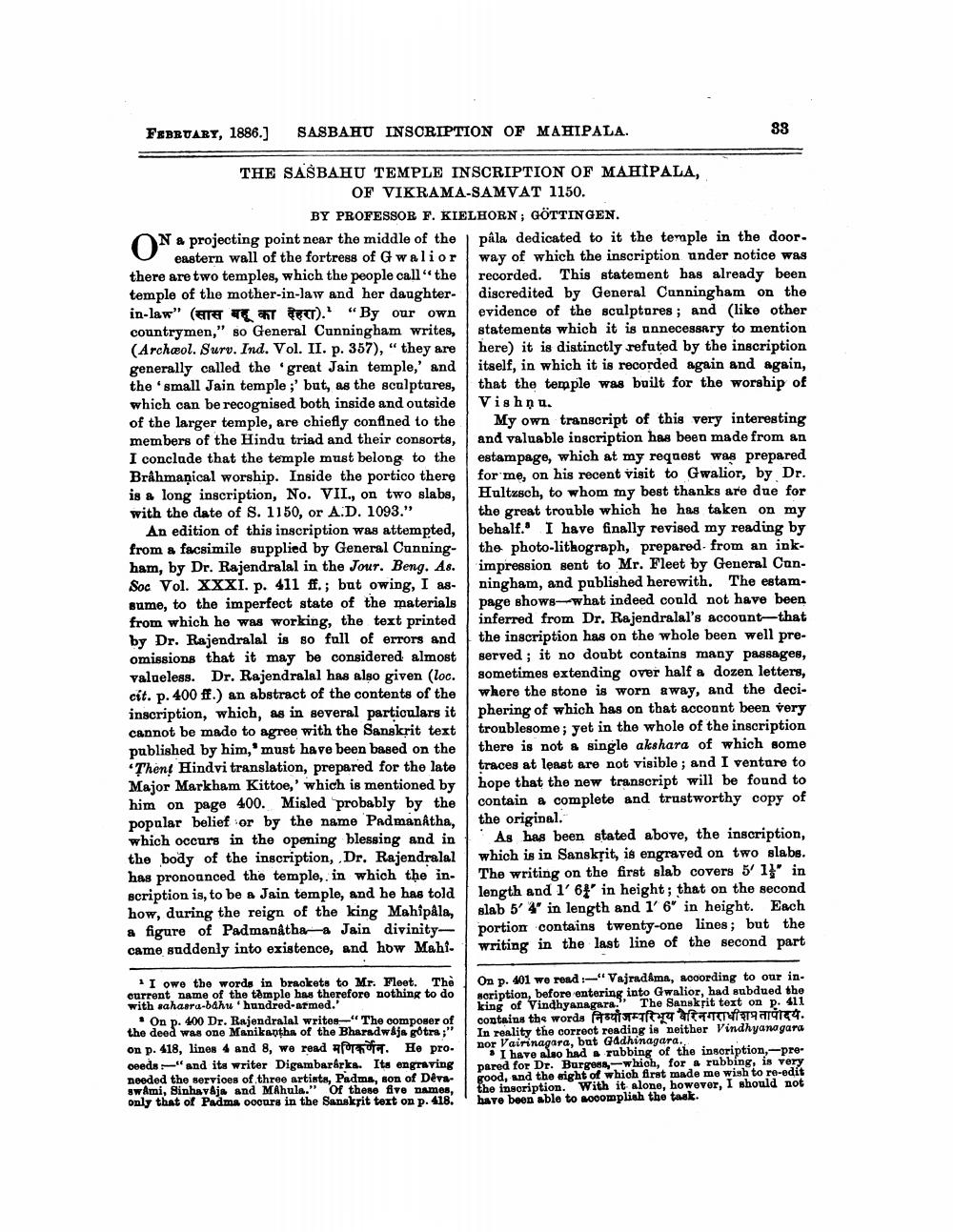________________
FEBRUARY, 1886.)
SASBAHU INSCRIPTION OF MAHIPALA.
83
THE SASBAHU TEMPLE INSCRIPTION OF MAHIPALA,
OF VIKRAMA-SAMVAT 1150.
BY PROFESSOR F. KIELHORN, GÖTTINGEN. Na projecting point near the middle of the pala dedicated to it the temple in the door.
eastern wall of the fortress of Gwalior way of which the inscription under notice was there are two temples, which the people call the recorded. This statement has already been temple of the mother-in-law and her daughter- discredited by General Canningham on the in-law" (ET R T SETT). "By our own evidence of the sculptures; and (like other countrymen," so General Cunningham writes, statements which it is unnecessary to mention (Archæol. Surv. Ind. Vol. II. p. 357)," they are here) it is distinctly refuted by the inscription generally called the great Jain temple,' and itself, in which it is recorded again and again, the small Jain temple ;' bat, as the sculptures, that the temple was built for the worship of which can be recognised both inside and outside Vishnu. of the larger temple, are chiefly confined to the My own transcript of this very interesting members of the Hindu triad and their consorte, and valuable inscription has been made from an I conclude that the temple must belong to the estampage, which at my request was prepared Brâhmanical worship. Inside the portico there for me, on his recent visit to Gwalior, by Dr. is a long inscription, No. VII., on two slabs, Hultzsch, to whom my best thanks are due for with the date of S. 1150, or A.D. 1093." the great trouble which he has taken on my
An edition of this inscription was attempted, behalf. I have finally revised my reading by from a facsimile supplied by General Cunning- the photo-lithograph, prepared from an inkham, by Dr. Rajendralal in the Jour. Beng. As. impression sent to Mr. Fleet by General Can. Soc Vol. XXXI. p. 411 ff.; but owing, I as- ningham, and published herewith. The estam. Bume, to the imperfect state of the materials page shows--what indeed could not have been from which he was working, the text printed inferred from Dr. Rajendralal's account-that by Dr. Rajendralal is so full of errors and the inscription has on the whole been well preomissions that it may be considered almost served; it no doubt contains many passages, valueless. Dr. Rajendralal has also given (loc. sometimes extending over half a dozen letters, cit. p. 400 ff.) an abstract of the contents of the where the stone is worn away, and the deciinscription, which, as in several particulars it phering of which has on that account been very cannot be made to agree with the Sanskrit text troublesome; yet in the whole of the inscription published by him,'must have been based on the there is not a single akshara of which some "Thent Hindvi translation, prepared for the late traces at least are not visible; and I venture to Major Markham Kittoe,' which is mentioned by hope that the new transcript will be found to him on page 400. Misled probably by the contain a complete and trustworthy copy of popular belief or by the name Padmantha, the original. which occurs in the opening blessing and in As has been stated above, the inscription, the body of the inscription, Dr. Rajendralal which is in Sansksit, is engraved on two slabs. has pronounced the temple, in which the in- The writing on the first slab covers 5 1}" in scription is to be a Jain temple, and he has told length and 1'64' in height; that on the second how, during the reign of the king Mahipala, slab 5' 4' in length and 1' 6' in height. Each a figure of Padmanathara Jain divinity- portion contains twenty-one lines; but the came suddenly into existence, and how Mahi.
writing in the last line of the second part
I owo the words in brackets to Mr. Fleet. The current name of the temple has therefore nothing to do with sahasra-bahu 'hundred-armed.'
On p. 400 Dr. Rajendralal writos -"The composer of the deed was one Manikanths of the Bharadwaja götra ;" on p. 418, lines 4 and 8, we read af . He pro. oveds "and ita writer Digambarkrks. Its engraving needed the servioes of three artists, Padma, son of Dévaswami, Sinhav ja and MAhula." of these five dames, only that of Padma oocars in the Sanskrit text on p. 418.
On p. 401 we read "Vajradama, according to our insoription, before entering into Gwalior, had subdued the king of Vindhyanagara." The Sanskrit text on p. 411 contains the words futottur aftan aritz4. In reality the correot reading is neither Vindhyanagara nor Vairinagara, but Gudhinagara.
I have also had rubbing of the inscription,-prepared for Dr. Burgess, which, for a rubbing, is very good, and the eight of which first made me wish to re-edit the inscription. With it alone, however, I should not have been able to aooomplish the task.




